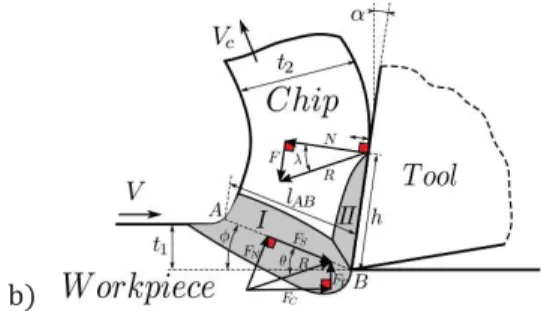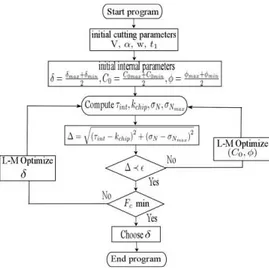OATAO is an open access repository that collects the work of Toulouse
researchers and makes it freely available over the web where possible
Any correspondence concerning this service should be sent
to the repository administrator:
tech-oatao@listes-diff.inp-toulouse.fr
This is an author’s version published in: http://oatao.univ-toulouse.fr/22948
To cite this version:
Dawoua Kaoutoing, Maxime and Houé Ngouna, Raymond
and
Beda, Tibi and Pantalé, Olivier
An analytical model of orthogonal
metal cutting: implementation using LMFIT library in Python.
(2018) In: The 8th International Conference on Structural Analysis
of Advanced Materials (ICSAAM 2018), 28 August 2018 - 31
August 2018 (Tarbes, France).
An Analytical Model of Orthogonal Metal Cutting:
Implementation using LMFIT Library in Python
Maxime Dawoua Kaoutoing
1,2, Raymond Houé Ngouna
1, Tibi Béda
2and Olivier
Pantalé
11
Laboratoire Génie de Production (LGP), Toulouse University, INP-ENIT, Tarbes, France
2 University of Ngaoundéré, Unit of Applied Physical Doctoral Training and Engineering, BP: 454 Ngaoundéré, Cameroon
Abstract
n this study an analytical model for orthogonal metal cutting is presented for predicting cutting forces and temperature at tool-chip interface. In this approach, the properties of the materials are modelled by the Johnson-Cook constitutive material flow law, where the stress is a function of strain, strain rate and temperature. The aim of the proposed work is to improve the numerical resolution of the analytical model. The determination of the optimal cutting parameters is based on the use of the Nonlinear Least-Squares Minimization and Curve-Fitting library for Python (LMFIT) whith a dual Levenberg-Marquardt optimization algorithm that has been developed and implemented in Python. The performance of the developed model has been studied by comparing its predictions with some experimental machining data for 1045 steels. A good correlation between the results of the proposed model and those resulting from literature and experiments has been demonstrated.
Keywords: Analytical Model, Metal cutting, Python Programming
1. Introduction
Today, the highly competitive machining industry pushes researchers to focus on the development of predictive models using analytical, experimental and numerical methods. These models are reliable tools, allowing manufacturers to improve productivity, machined surface quality and real-time monitoring of the machining process. Empirical modelling requires extensive experimental work and, therefore, is expensive and the applicability of the results obtained is limited to the tested condition domain only. On the other hand, numerical modelling requires a lot of computation time and a high performance computer. In conclusion, the analytical modelling seems to be the optimal solution for machining process modelling, because it allows to connect physical phenomena to process parameters with a reduced computation time and few experimental data entries. This study presents an improvement of an analytical model for metal cutting. Implementation using the LMFIT library in Python is used for the determination of cutting parameters. First we present the synthesis of the analytical models available in the literature and then we implement the extended-Oxley model using the Python LMFIT Library and a comparison of the results of the proposed model with those of the previous models is made.
2. Ext-Oxley analytical model of orthogonal metal cutting
Many researchers have formulated and improved analytical metal cutting models using the configuration of orthogonal cutting. Merchant [1] early developed a shear plane model with the assumption that the shear angle is determined by minimizing the total power of cutting process. Lee and Shaffer [2] proposed a model based on the slip-line field theory and some deformation experiments. Those plane shear and slip line models does not consider the effect of stress and the rate of deformation. In 1963, Oxley et al. [3] proposed a slip line model with
two shear zones: the primary and the secondary shear zones (Figure 1a) by taking into account the thermomechanical aspect of machining. This model results from the fusion of a mechanical part and a thermal part based on the work proposed by Boothroyd [4,5]. This model takes into account the thermal properties (specific heat and thermal conductivity of the material to be machined and the tool), the effect of stresses, strain and temperature in the primary shear zone and tool-chip contact zone. Oxley improved his model over time [3,6] and proposed in 1989 [4] a predictive machining theory, known as the Oxley’s machining theory. This theory makes it possible to predict, depending on the cutting conditions, the cutting forces, the average temperature and the stresses and strains in the shear zone and along the tool-chip interface.
a) b)
Figure 1: Chip formation model
According to the Oxley theory, one must verify two equilibrium equations and minimize the cutting force (Figure 1b) defined by equilibrium system (1). In this equilibrium system, there still exist three unknown parameters: the shear angle , the ratio of to the thickness of the primary shear zone denoted by and the ratio of the thickness of the secondary shear zone to the chip thickness :
! ( ( ) ) ( ( ) )
( )
(1)
The approach used by Oxley et al. [3], Lalwani et al. [7], Xiong et al. [8] and many other authors for the solution of this system of equations consists in determining the set of internal parameters ( ) by introducing a trial and test algorithm based on a triple loop computation. They select each time, the corresponding parameter so that one of the three conditions defined by (1) is satisfied each time, i.e. [ ] satisfies the first equation of
system (1), [ ] satisfies the second equation of system (1) and [ ] minimizes the cutting force . One can note the following principal drawback to the proposed approach: first is the number of computations: 40*81*401 = 1 299 240 loops, for selecting at the end only one among all those computations, second is the selected values for the increments of the three parameters is quite coarse so that the solution, at end the solution might not be unique.
3. Oxley-LMFIT model and Implementation using Python
In order to solve the system (1), we propose here after an alternative, and more efficient, approach based on an optimization method implemented in Python 3 language [9]. We have selected the LMFIT [10] module for the core of the optimization algorithm as this one proposes an efficient and easy to use implementation of the Levenberg-Marquardt algorithm [11,12]. The lmfit module provides a highlevel interface to non-linear optimization and curve fitting problems for Python and provides the Levenberg-Marquardt algorithm of Scipy, but also supports most of the optimization methods from scipy.optimize. The main advantage over the classic Scipy implementation is the ability to provide a useful parameter object which has a value that can be varied in the fit, be fixed, or have upper and/or lower bounds. The general flowchart of the proposed algorithm is presented in Figure 2). From this later, it can be seen that the system (1) is solved by two optimization algorithms enclosed one into the other one and referred here after by the denominations of internal optimization algorithm and global optimization algorithm respectively. The internal optimization algorithm is in charge to solve the first two equations of system (1) while the global optimization algorithm is in charge to find the minimum value of the cutting force i.e. the last equation of system (1). Therefore, because of the imbrication of the algorithms, the final solution is the one so that the equilibrium condition is satisfied in a first step through the following objective equation (2). In order to check how the proposed algorithms works, and conforming to the results proposed by Lalwani et al. [7], an improvement of Oxley-LMFIT model and implementation using Python has been presented. The predicted values of cutting force, thrust force and temperatures are calculated with total error of the equilibrium part of the system less than Pa while for Lalwani approach the same
error is about 20 MPa, the total number of optimal parameters search loops has been drastically reduced from 1 299 240 loops down to 249 loops (5000 times less) so the new proposed algorithm is 5000 times faster for the original algorithm. The uniqueness of the solution has been demonstrated apart from this presentation.
! ( ) ( )" # ( ) ( ) $ (2)
Figure 2: General flowchart of the proposed Oxley-LMFIT model
4.
Conclusion
An Improvement of the Extended-Oxley analytical model of orthogonal metal cutting and implementation using LMFIT Library in Python has been presented. For this study, a work material constitutive model developed by Johnson and Cook is used as the work flow stress model. NonLinear Least-Squares minimization and Curve-Fitting for Python (LMFIT) is used and a dual Levenberg-Marquardt optimization algorithm has been developed and implemented in Python software. The predicted results of cutting and advancing forces and temperature under proposed method (LMFIT) are closer to the experimental data for AISI steal. The proposed method has resulted in higher precision. The uniqueness of solution have been demonstrated. In the future work, the analytical model will be extended to take account the sticking and sliding regions in a new unified algorithm.
References
[1] M.E. Merchant, H. Ernst, Chip formation, friction and high quality machined surfaces, Transactions of American Society for Metals, 29:299-378, 1941.
[2] B.W. Shaffer, E.H. Lee, The theory of plasticity applied to a problem of machining, Journal of Applied Mechanics, 18:405-413, 1951.
[3] W. F. Hastings, P. L. B. Oxley, Minimum work as a possible criterion for determining the frictional condition at
the tool/chip interface in machining, Sir Hugh Ford, F. R. S., 1975.
[4] G. Boothroyd, Temperatures in orthogonal metal cutting, Proc. Inst. Mech. Eng. 177, 789–802, 1963.
[5] G. Johnson, W. Cook R, A constitutive model and data for metals subjected to large strains, high strain rates an
high temperatures, Proceeding of the 7th Int. Symposium on Ballistics, Hague, The Netherlands, 541- 54, 1983.
[6] P.L.B. Oxley, Mechanic of machining: an analytical approach to assessing machinability, Ellis Horwood Limited, 1989.
[7] D. I. Lalwani. Extension of Oxley's predictive machining theory for Johnson and Cook flow stress model, Journal of materials processing Technologies, pages 5305-5312, 2009.
[8] L. Xiong, J. Wang, Y. Gan, B. Li, N. Fang, Improvement of algorithm and prediction precision of an extended
Oxley's theoretical model, The International Journal of Advanced Manufacturing Technology, 77, 1-13 ,
[9] G. Rossum, Python reference manual, Tech. rep., Amsterdam, Netherlands, 1995.
[10] M. Newville, A. Nelson, T. Stensitzki, A. Ingargiola, D. Allan, et al., LMFIT: nonlinear least-square
minimization and curve-fitting for Python, Astrophysics Source Code Library.
[11] K. Levenberg, A method for the solution of certain non-linear problems in least squares, Quarterly of applied mathematics 2 (2), 164–168, 1944.
[12] D. Marquardt, An algorithm for least-squares estimation of nonlinear parameters, Journal of the society for Industrial and Applied Mathematics 11 (2) (1963) 431–441.

